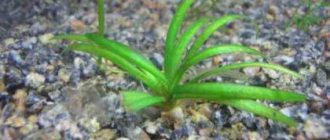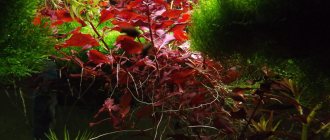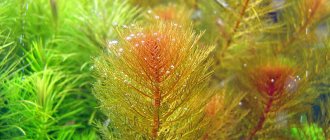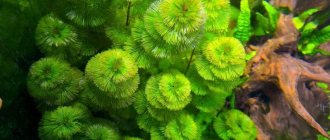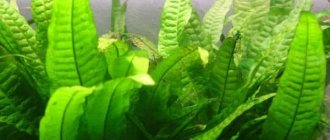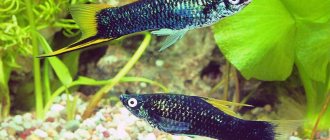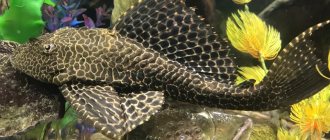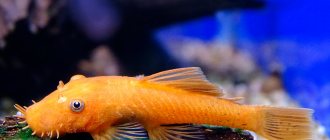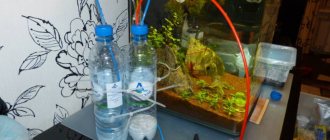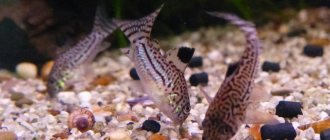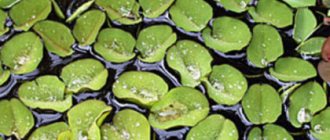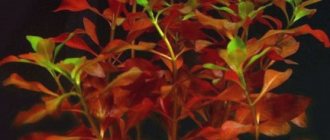A comfortable living environment is important to all living things on earth. It improves development, growth, and well-being, so even in aquariums, vegetation must be present. Now many varieties of plants have been sufficiently studied and are in demand, but the most significant are ferns.
The fern is famous for its regular reproduction, as well as its attractive appearance, so any aquarium with its presence looks like a real botanical garden, only inside a home pond.
Such a plant will never interfere with either other vegetation or the fish themselves. At the same time, waterfowl can freely hide under its foliage and swim freely, so the fern vegetation looks good and does not create inconvenience for pets living in the neighborhood. It is planted both in the central part of the aquarium and along the outskirts. In addition, fern is a good source of oxygen release.
Types of aquarium ferns
Plants grown in aquariums are usually classified by species, within each of which several subspecies can be distinguished:
- Thai (Javanese);
- Indian;
- Bolbitis.
For a Thai aquarium microzorium, the best conditions are subtropical - high temperature and humidity. Characterized by elongated roots with many branches. It has lanceolate leaves, the surface of which is covered with small tubercles. The rhizome is always located on top of the soil. Thailand fern is classified according to its shape:
| Name | Description |
| Narrow-leaved | It looks like a shrub formed by long stems and leaves. On the stems there is a root system in the form of barely noticeable villi. |
| Vindelova | The leaves of the microzorium branch in the upper part, which adds to the appearance of splendor. An adult fern can stretch up to 30 cm, having a width of about 5 cm. It has a weak root system. |
| Trident | It has horizontal shoots capable of rooting in the ground. Many elongated, narrow-shaped leaves with 2-5 lateral processes on each side. Grows up to 15-20 cm. |
The Indian fern, often found in tropical regions, can be recognized by its thick stem that supports branches that grow in all directions, with light green foliage. When separated, the leaves are capable of independent development, as they contain shoots in huge quantities. May be wing-shaped (ceratopterys) or lacy. The second one is easily distinguished from the first by the longer length of the leaves.
Bolbitis stands out for its strong horizontally growing stem, which is decorated with soft golden scales. The leaf plate has a mesh structure. An adult plant stretches up to 60 cm; leaves are hard and up to 20 cm wide.
In addition to the most common ferns among aquarists, the following are less popular with a spectacular appearance and deserve mention.
Azolla Caroline
A small-leaved fern that can develop both at depth and on the surface of the water. The stem is covered with spores and delicate pink-green leaves. The large surface part is light green and absorbs compounds necessary for growth.
Horn-shaped
It stands out for its feathery complex leaf plates of light green color. Has a fragile root system. In artificial conditions it grows up to 50 cm.
Salvinia
A small fern with a stem floating on the water with whorls consisting of leaves on and under the surface of the water. Beneficial compounds are absorbed through underwater. In large quantities it causes the pond to turn black.
Marsilia
All varieties have long roots and stems that grow on the sides, holding the leaves on the top. Similar in appearance to clover. They can rise up to 12 cm, the leaves grow up to 2 cm in diameter.
Hornwort
A long, bushy stem with many thin, fluffy-looking leaves similar to pine needles. The shell contains cutin, which causes a greasy feeling when touched.
Read more in the article about hornwort.
Malay
It has light green, dissected leaves. The height of the fern is up to 25 cm and can grow without rooting in the ground.
Monte Carlo
The stems are thin, branching, the leaves form a plant carpet of bright green color. The roots are white, thread-shaped, and grow quickly.
Subspecies
Several varieties of Thai fern are used for breeding.
Small leaf
A small plant with leaf heights up to 6 cm. Grows at water temperatures no higher than 30 degrees, neutral acidity and dH 0-30º.
True angustifolia
Features of the species: rich, dark color of sheets only 0.5 cm wide.
Narrow-leaved
A small subspecies up to 20 cm high, used for the design of small aquariums. Unique due to its curly appearance.
Red
The leaves of the young plant are reddish in color. As they grow, they change to their usual green hue.
Vindelov
The branching pattern on the plant's leaves makes it a favorite among those who create unique aquarium designs. It gets along with herbivorous fish, does not require special care, and grows 20 cm in all directions.
Tropica
The structure of the leaves resembles a dandelion. The length of an adult bush reaches 40 cm, so this variety of fern is best planted along the edges of the container.
Pterygoid
Externally similar to the classic version of Microsorum pteropus. Suitable for growing in salty, sea water. The length of adult leaves is 35-40 cm.
Vicofolia
There are many “horns” on the sides of all sheets. A slow-growing, rare species of aquatic shrub, characterized by slow leaf growth.
Undulata
The most expensive variety is light green in color and has wavy leaves.
All of the listed types of ferns are suitable for decorating aquariums, get along well with fish and retain their appearance for a long time without special care.
Plant care rules
For water ferns, it is not necessary to look for a high quality ceramic substrate. You can use soil with silt with a layer thickness of up to 5 cm. It is recommended to place small stones on the bottom, which will help the plant gain a foothold in new conditions.
If leaves with a developing root system appear on the surface of the aquarium, you need to move them to another tank.
When comfortable conditions are created, the plant reproduces all year round, so in case of excessive growth, it is better to remove unnecessary parts. Replanting an established fern is done only when absolutely necessary due to long-term adaptation to the new environment.
Possible diseases
This aquatic crop does not have a real root system; the plant draws all its microelements directly from the water. If there is not enough nitrogen or other elements, the growth of the Thai fern will slow down and some problems may also appear. Quite often, the leaf blades of this aquatic plant begin to turn black if the hardness of the water environment increases, so beginners should regularly monitor and control the chemical composition of the water.
To prevent the occurrence of diseases in the Thai fern, you need to monitor the purity of the water.
In addition, some aquarium fish can cause damage to the root system when they dig up the soil. If you quickly remove damaged areas of the fern, this will promote rapid growth of new foliage and roots.
Lighting requirements
Keeping an aquarium in the dark negatively affects the condition of the plant - unlike the floater (Selaginella), the fern, like the Ficus Benjamin, experiences wilting, which can result in disease. The correct lighting scheme prevents it from turning yellow and darkening and guarantees growth without delays.
To create it, lamps are installed next to the aquarium:
- luminescent (power calculation 0.5 W per 1 liter of liquid);
- incandescent (the value is 3 times less than in the first case).
It is better to limit the duration of daylight to 12 hours, regardless of the time of year.
average price
Buy plants for your aquarium in specialized stores, and not from others.
The average price for a young plant can be within 150 rubles , but the Vindelova fern costs more - about 250 rubles .
By purchasing this exotic plant for his aquarium, the owner solves several pressing problems: decoration of the reservoir, its aeration and purification.
In addition, the fern is distinguished by its unpretentiousness and long life cycle, which, of course, makes it a favorite among other aquarium plants.
How to plant a fern in the ground
The plant is placed on the bottom of the aquarium without special soil preparation in a place with a few pebbles that will help it fix itself and begin to develop in a new environment. At home, you can use additional means for placement near snags or stones in the form of a thread made of nylon or fishing line. The most reliable fastening is provided by rubber bands. The other side of the coin is that the aquarium loses its attractiveness, being filled with elements that contrast with the main concept.
There is an option to plant the plant using waterproof glue. For fixation, you do not need to fill the entire plate; a few drops at the contact points are enough. The roots will not remain at the gluing site, but by this time the fern will have grown and will be securely adjacent to the support.
Possible problems
Most often, aquarium cultures suffer from poor water and soil conditions, which can lead to a lack of macro- and microelements important for growth. Signs of illness:
- leaves turn black;
- green mass decreases in size;
- fern grows very slowly;
- the appearance of yellow veins.
To restore the balance of essential microelements, you will need to adjust the acidity of the liquid, as well as additionally use fertilizers for aquarium plants.
See below for information on aquarium ferns.
Plant propagation
If comfortable conditions are provided in the aquarium, the process does not always require outside intervention. For example, in the Indian fern, old leaves are covered with shoots. At the next stage, the process of forming a bunch of roots and tearing them off along with new sheets begins. The processes progress both during swimming and when planting in the substrate.
The approach to breeding depends on the type of fern. For example, the following recommendations are relevant for Thai speakers:
- Speeding up the process with your own hands. The plant is carefully cut into separate pieces, each of which contains roots and leaves. Shoots will develop on the surface of the water (similar to marsh algae) or when buried in sand.
- Natural breeding. Growth buds fill the old leaf, acting as the basis for new shoots with roots, which begin to fall off and then rise. Over time, the rhizomes pull them down, which helps anchor them in the ground.
The reproduction rate of aquatic ferns (including Anonymus) is low. However, the plant can occupy all the free space of the aquarium. To avoid overgrowing, you need to remove excess parts and plant them in separate containers.
Tips and reviews
Difficulties may arise in the process of planting the Thai fern. Advice from experienced specialists will help solve some of them.
- Dark spots appear on the leaves of some bushes over time. These are genitals that do not need treatment.
- If the bush grows slowly a few weeks after planting, you need to add some liquid fertilizer to the water.
- The leaves of young plants are most susceptible to influence from fish, especially cichlids. You should not plant the plant where crayfish, catfish or corydoras live.
The only thing left to do is to plant the Thai fern in your own aquarium in order to visually evaluate its appearance and positive impact on the inhabitants.
Compatibility with aquarium inhabitants
Ferns get along well with small fish that swim and spawn in the leaves, which is important to consider when creating Dutch aquariums. Planting next to tall plants will cause problems due to their intertwining, and careless untangling will damage the stems and foliage.
Fish that are accustomed to digging should not be grown in the same tank with ferns, as their activity will affect the condition of the rhizomes. The consequences can be different, including the death of plants.
Ferns have the ability to absorb nutrients. This does not affect other inhabitants of the aquarium in any way.
Content Rules
In order for a fern to grow and develop in an aquarium, it needs to be provided with the right conditions in a closed environment.
- As for the liquid, soft water of slightly acidic or neutral composition will be suitable for the culture. Hardness should be maintained at 6 dGH, while acidity should be at 5-6 pH.
- It is also important to maintain a constant water temperature. The optimal indicators for fern will be values in the range from 20 to 24 degrees.
- Replacing some of the liquid in an aquarium is a mandatory requirement not only for marine life, but also for plants. For tropical crops, you will need to change at least a third of the total liquid once a week.
- Despite the fact that plants themselves act as a natural filter, additional water purification will not hurt them. That is why it is recommended for the aquarist to place a filter in the container and also ensure proper aeration of the liquid.
- A significant part of ferns belong to light-loving crops; the presence of good lighting allows them to develop properly and increase in size. Daylight hours for them should last at least 12 hours, even in winter. Fluorescent lamps are usually used for these purposes.
- Crops respond positively to the introduction of additional fertilizers. In order for plants to grow actively, fern urea can be added to the water. For 100 liters of water it will be enough to use 1 or 2 fertilizer granules per week.
Ambulia
Ambulia - the owner of delicate leaves
Ambulia (Limnophila aquatic) is a beautiful large plant. If there is enough free space in the aquarium, it forms dense thickets. On a long and dense erect stem there are many needle-shaped leaves that form lush hats or umbrellas, the diameter of which sometimes reaches 12 cm. The height of the stems when kept at home usually does not exceed half a meter; in nature, the plant has a height of up to a meter.
Ambulia is a good natural filter that will help you clean your aquarium of suspended matter and contaminants.
When keeping ambulia in aquariums, it is important to remember that it has its own daily cycle: in the evening its leaves fold, and the plant goes into hibernation for several hours, and in the morning the umbrellas open again. The intensity and mode of lighting have virtually no effect on the activity schedule of limnophila
The roots of the plant are well developed, so when placed in an aquarium, Limnophila is planted in the ground. It is enough to maintain the temperature in the container within the range from +22 to +28ºС, as well as neutral acidity. Water hardness is not particularly important. If the parameters deviate from the optimal ones, the plant slows down its growth and its color becomes paler, but ambulia is capable of surviving in such conditions for a short time.
The greatest danger to it comes from herbivorous fish, which are attracted to the delicate leaves. However, with good feeding, your pets will only destroy accidentally torn off shoots without violating the integrity of a healthy plant.
